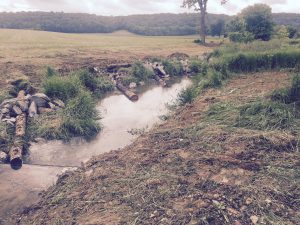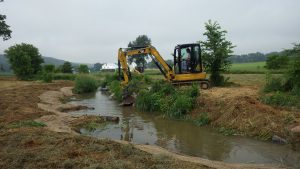 While there are a couple days left in August, we’re going to wrap-up Water Quality month. Over the past weeks, we’ve shared information about various measures of water quality. Now, we want to share some information about the projects being done in the Limestone Run Watershed of Montour and Northumberland Counties.
While there are a couple days left in August, we’re going to wrap-up Water Quality month. Over the past weeks, we’ve shared information about various measures of water quality. Now, we want to share some information about the projects being done in the Limestone Run Watershed of Montour and Northumberland Counties.
The map at the top of the page shows the whole watershed – from its headwaters in Montour County to where it enters the West Branch Susquehanna River in Milton, Northumberland County. The properties highlighted in yellow (or green depending on your screen) are all properties that had some type of project done to improve water quality. On some it was a major construction project with lots of concrete to keep manure out of the stream. On other sites it may have simply been planting trees and shrubs along the banks of the Limestone Run to shade the water and allow the plants’ roots to hold the soil in place.
 Others have had in-stream habitat structures installed. The in-stream structures allow for a holistic approach. The structures are constructed from log and rocks to stabilize the stream banks, stop the erosion, and restore over-widened stream channels back to a more stable width. These structures reduce if not eliminate the accelerated erosion issues, while at the same time, the in-stream structures are also providing enhanced aquatic habitat in the streambed.
Others have had in-stream habitat structures installed. The in-stream structures allow for a holistic approach. The structures are constructed from log and rocks to stabilize the stream banks, stop the erosion, and restore over-widened stream channels back to a more stable width. These structures reduce if not eliminate the accelerated erosion issues, while at the same time, the in-stream structures are also providing enhanced aquatic habitat in the streambed.
The in-stream rock and log structures have been used by PFBC for over 40 years to reduce velocity on the stream banks and re-direct the flow back toward the center of the channel. They are installed to function at normal flow conditions, and continue to function even during high flow events. The structures immediately remove the velocity from the toe-of-slope (where land and water meet) and allow the stream banks to stabilize. To further assist during high flows, the banks are re-graded to create a more gentle slope.
 Generally the stream channel is over widened due to a lack of deep-rooted vegetation and/or cattle access. The deep roots of vegetation hold the soil in place. When those roots are lacking, the soil is more likely to move, or erode away. The structures are placed to stabilize the toe-of-slope to allow deep-rooted vegetation to establish. This allows us to aggressively accelerate the stabilization process. This reduces the overall amount of sediment the stream system receives, and begins to improve aquatic habitat immediately.
Generally the stream channel is over widened due to a lack of deep-rooted vegetation and/or cattle access. The deep roots of vegetation hold the soil in place. When those roots are lacking, the soil is more likely to move, or erode away. The structures are placed to stabilize the toe-of-slope to allow deep-rooted vegetation to establish. This allows us to aggressively accelerate the stabilization process. This reduces the overall amount of sediment the stream system receives, and begins to improve aquatic habitat immediately.
 Three of the sites, Schnure, Pfleegor, and Smith are sites that Susquehanna University’s RK Mellon Freshwater Laboratory visited before construction to get a baseline on the fish species and macroinvertebrates. NPC has applied for funding to have the Susquehanna team sample the sites again 1 year after the instream structures are installed and then at 2 years after.
Three of the sites, Schnure, Pfleegor, and Smith are sites that Susquehanna University’s RK Mellon Freshwater Laboratory visited before construction to get a baseline on the fish species and macroinvertebrates. NPC has applied for funding to have the Susquehanna team sample the sites again 1 year after the instream structures are installed and then at 2 years after.
Thanks to Montour County Conservation District, Northumberland County Conservation District, U.S. Fish and Wildlife Service, PA Fish and Boat Commission, PA DEP, this summer’s interns (Brandon, Shane, and Richard), and the landowners for getting so much work done this summer!

